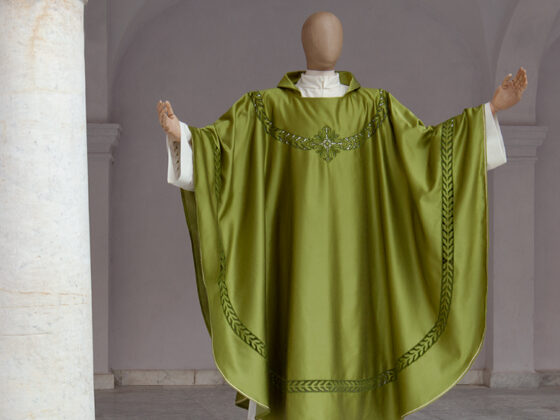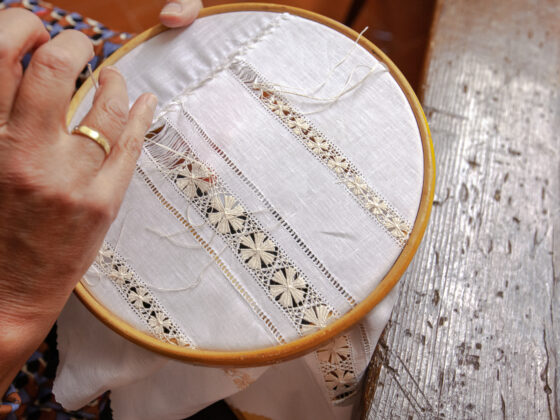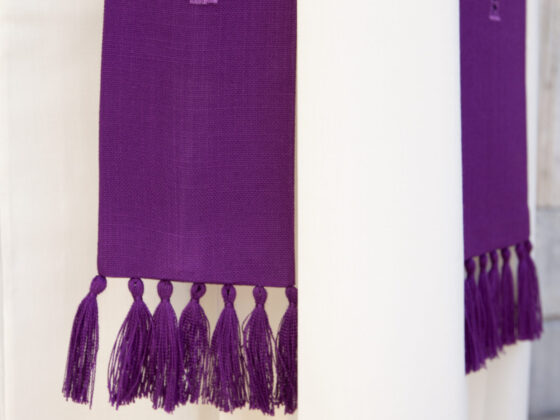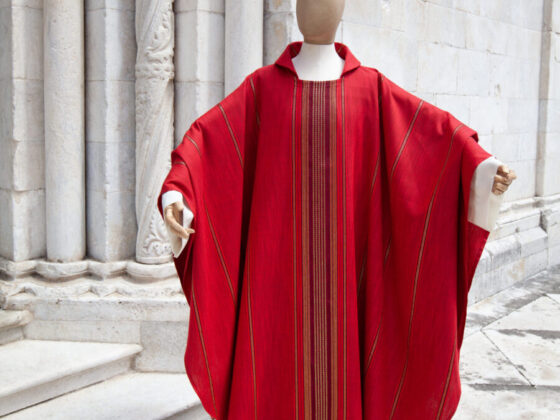An essential accessory for many religious orders and for the priest during every function, the cincture has accompanied the alb since the beginning of Church history. A rope tied around the waist, descending parallel along the sides, whose meaning holds much more than just a simple accessory.
What is the cincture?
The cincture is a rope that the priest ties around the waist over the alb. It is considered an accessory of the alb and, as such, has very ancient origins. The cincture, like the alb, is an accessory that was already found in Roman customs. In fact, the Roman tunic was left loose at home but, when going out, it was tightened at the waist with a cord or belt, primarily to facilitate movement. The shape and material used for the liturgical cincture are directly derived from this type of belt. Initially, in Spain, the cincture ended with a strap fastened with silver or ivory closures, but it is the “Roman” cincture that later spread throughout the West, becoming the one used in liturgy.
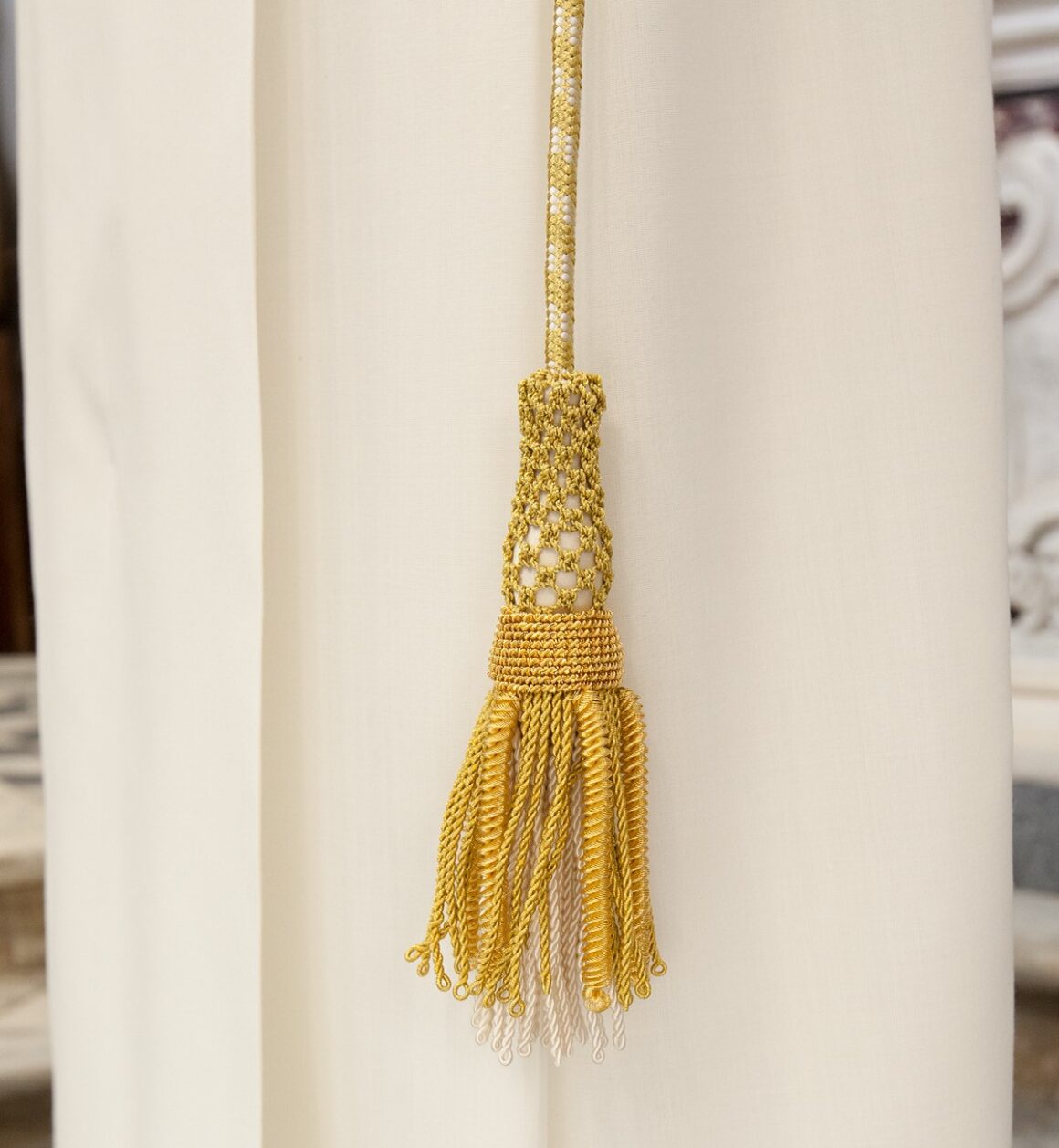
When does the cincture begin to be used in the liturgy?
Pope Celestine I was the first to mention its liturgical use in his Epistle to the Bishops of Gaul in the year 425 AD. In this letter, the Pope reprimands those priests who wear “rough garments” instead of the prescribed liturgical vestments and who do not wear the cincture. Rabano Mauro, Archbishop of Mainz (780-856 AD), and Amalarius (775-850 AD), a French bishop of the same period, also mention it in their writings, attesting to the widespread use of this garment in the Carolingian era.
Its connection with the alb is such that, in medieval inventories, ordinary cinctures were often not listed, as it was considered implicit that the cincture would be worn with the alb. Only the more prized cinctures, those adorned with gold and silver galloons and trimmings, were noted.
Regarding its construction, Cardinal Carlo Borromeo, in his book “Instructionum Fabricae et Supellectilis ecclesiasticae” from 1577, states that the cincture should be made from soft hemp or linen fiber, a directive, however, that was not always followed over time. In fact, in 1701, the Congregation of Rites, an agency of the Roman Curia responsible for liturgy, decided that the cincture could also be made of silk and wool.

Regarding decoration, in the 12th and 13th centuries, cinctures were adorned with metal spheres or terminal pieces in square or trapezoidal shapes, a common feature at the time also for stoles and maniples. From the late 16th century in Rome, the end part of the cincture was often finished with significant tassels or rich fringes. Both white and colored cinctures have always been permitted, as long as the color matched the color of the vestment.
What is the meaning of the cincture?
Much of the meaning of the cincture can be deduced from the vesting prayer still used by priests today:
“Praecinge me, Domine, cingulo puritatis, et exstingue in lumbis meis humorem libidinis; ut maneat in me virtus continentiae et castitatis” (Gird me, Lord, with the cincture of purity, and extinguish in my loins the moisture of lust, so that the virtue of self-control and chastity may remain in me).
This prayer is inspired by the First Letter of Peter (1:13). In verse 13, Peter exhorts to “gird the loins of your mind” and to “set your hope fully on the grace that will be brought to you” — meaning to be ready to abandon one’s own way of thinking and plans in order to follow those that Jesus has for us, remaining focused on the path without distractions.

The invitation to gird the loins is found in other passages of the Bible. Two well-known examples are in Exodus, where the Israelites celebrate the Passover lamb “with their loins girded, sandals on their feet, and staff in hand […]”, and in the Gospel of Luke (12:35), “Be dressed ready for service and keep your lamps burning.” In both cases, the reference to girding the loins is an exhortation to be ready and always on the move toward a goal, with an attitude of service.
Liturgists began very early to write about the meaning of this garment. Rabano Mauro, abbot and archbishop, describes the cincture as a symbol of “custody of the mind,” that is, self-control, especially with regard to sexual desire or arrogant attitudes where personal pride predominates. He considers it so important that he classifies it as “the third vestment,” after the chasuble and the alb. Amalarius, like many other liturgists, sees in the cincture the symbol of abstinence and the control of more sensual impulses.

Guglielmo Durante, a French bishop (1230-1296), writes in his book Rationale Divinorum Officiorum that the alb must be fastened around the hips both to prevent the loose fabric of the tunic from hindering walking and as a reminder to the priest to keep his service chaste and pure. The author of the Rationale also considers the cincture as a true liturgical vestment.
The priest’s cincture from Arte Ricami
Arte Ricami offers a wide range of cinctures for both weekday celebrations and more important occasions. You can choose from cinctures with simple fringes, cinctures with tassels in gold bullion, or even cinctures entirely made of “gold.” Our cinctures are sold in special packaging, making them a perfect gift for a priest. For more information about our cinctures and all our hand-embroidered products, or to find the nearest retailer, contact us at the following email address info@artericamiliturgico.com.
Follow us on Facebook e Instagram to stay up-to-date on all news and our customised orders.
